Martindale Animal Clinic

Kitten Care
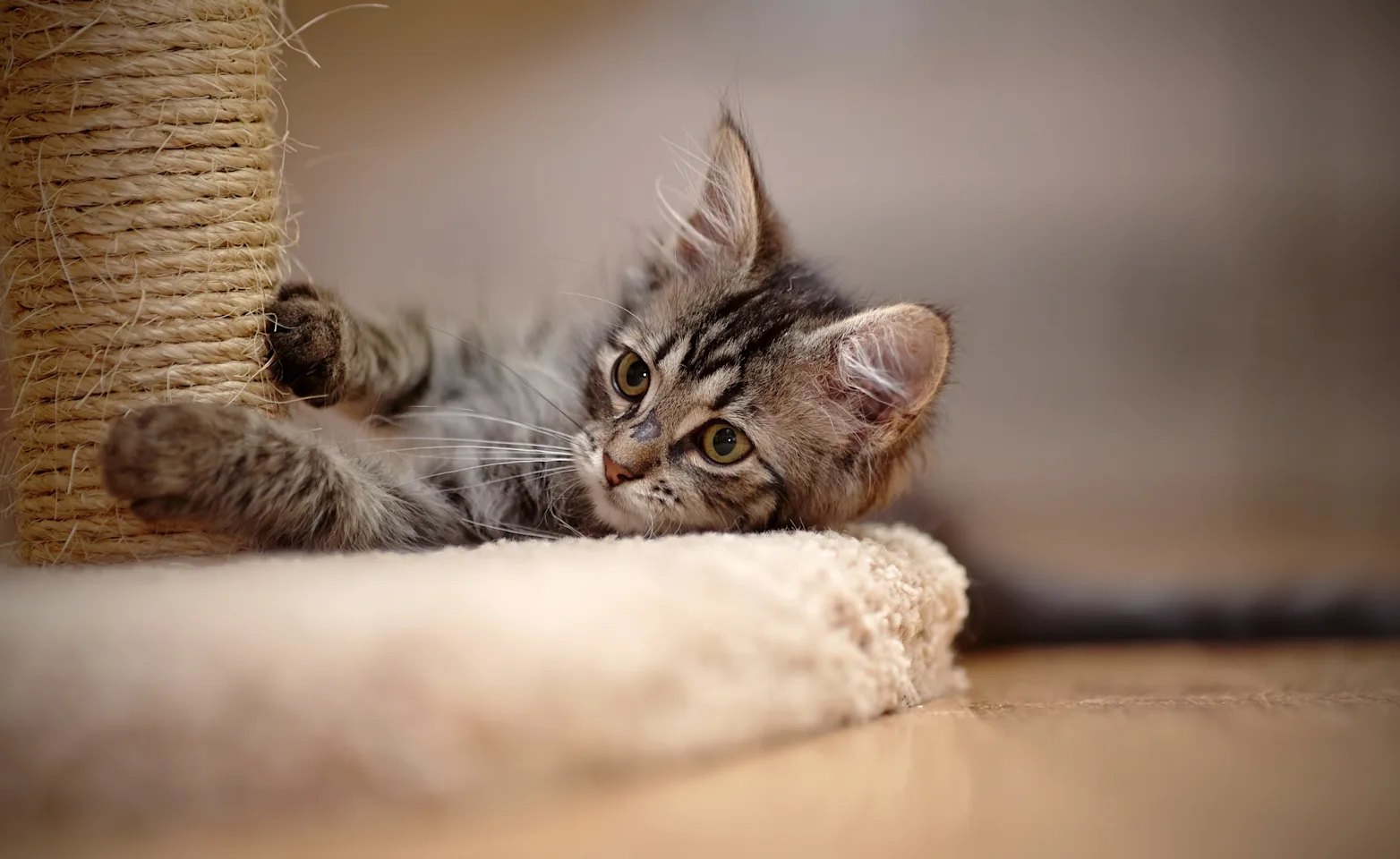
Preparing for Your New Kitten
Your new pet is an adventure. Keep things simple, plan to have fun and remember your new friend could be with you for 14-20 years, so it is important to begin with some planning and information.
Thank you for bringing your kitten to Martindale Animal Clinic for their first checkup. We are committed to providing the best care possible. We have the benefit of multiple experienced veterinarians who consult regularly with each other. We also have the amazing support of Registered Veterinary Technicians and very experienced team members. We have an in-clinic laboratory enabling us to acquire test results very quickly — a benefit for any sick patient. In our "hospital area," we have a heated floor, dog runs that have clear doors, and kennels where we set up comfortable clean rest areas for our patients.
The most important thing to know about Martindale Animal Clinic is that it is our goal to partner with you to give your kitten the best life possible. Each veterinarian and team member at Martindale Animal Clinic is deeply committed to the health and well-being of your kitten. We love animals as much as you do. We are here to advise and help you every step of the way with your pet, so if we can offer any assistance please don't hesitate to call.
Veterinarian
Keep the name and phone number of your Veterinarian and your Local Veterinary Emergency Clinic handy:
Martindale Animal Clinic (905) 682-5551
Niagara Veterinary Emergency Clinic (905) 641-3185

Kitten's First Things
High Quality Kitten Food
Veterinary Prescription diets are the most advanced nutrition available. These diets are sold exclusively through veterinarians including Martindale Animal Clinic, and are special formulations made by Royal Canin, Hills, Purina or lams.
Food and water bowls
Preferably stainless steel, glass or ceramic. Plastic bowls can encourage bacteria buildup. Many cats prefer wide mouthed bowls, especially for water, or running water fountains. Cats prefer not to touch their whiskers on anything when eating and drinking.
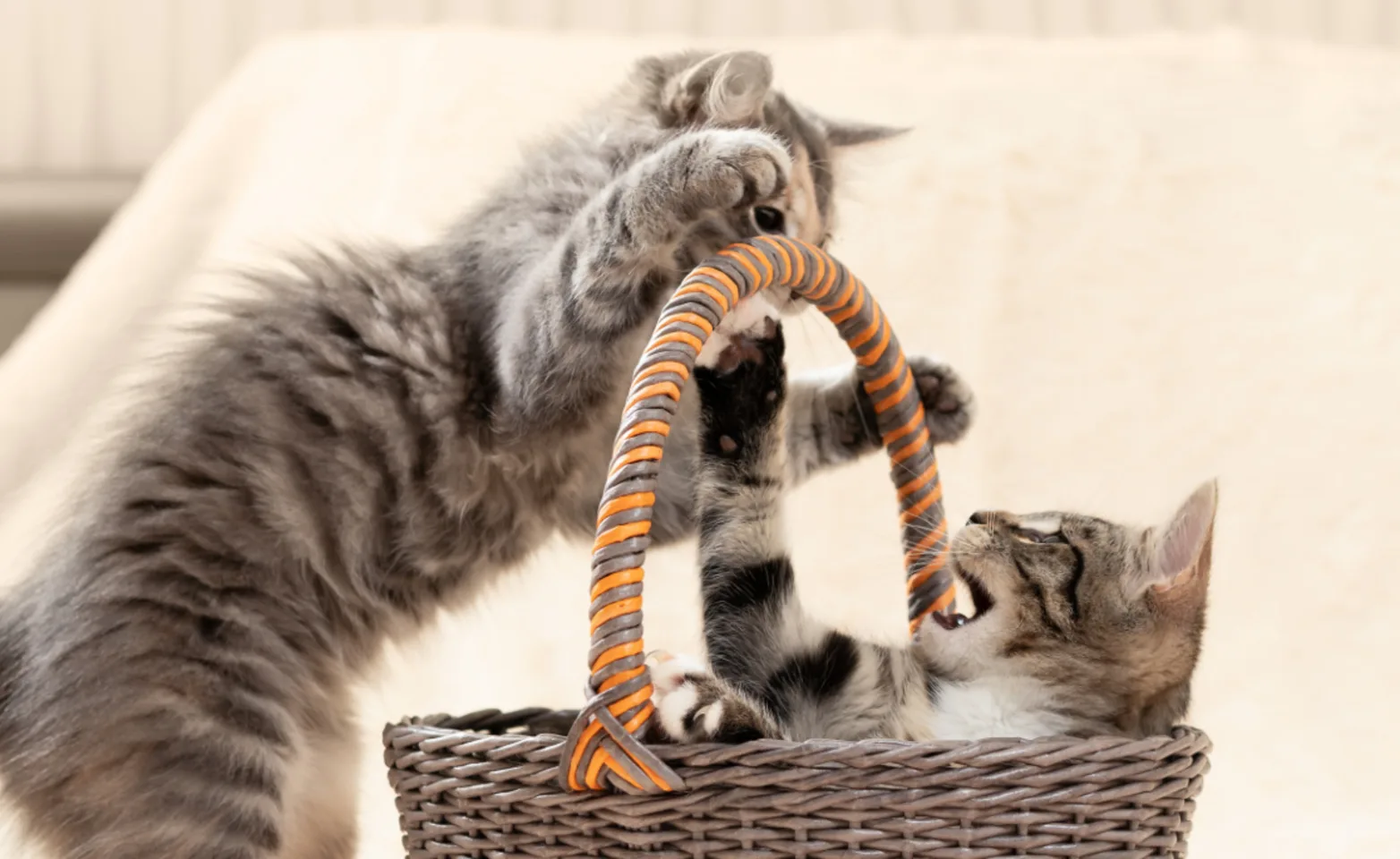
Litter Box
Larger is better! ie. 3 feet long by 2 feet wide
Grooming Tools
Flea Comb
Wide Tooth Comb
Nail Clippers
Cat Carrier
This should be large enough to comfortably once he has grown to his/her adult size. If you ever plan to fly with your pet, we recommend consulting with an airline so you have the appropriate carrier.
Toys!
Cat toys that dangle from a door handle or scratching post
Mobile-like toys that sway and bounce when swatted
Scratching posts
All toys should be large and sturdy enough that they cannot be broken or ingested. Some of the best toys are cardboard boxes and large paper bags!
Kitten Proofing Your Home
Get down on your hands and knees to assess potential hazards (at their level)
Ensure all windows and screens are securely closed
Keep your kitten away from balconies or high places
Store all cleaning supplies and potentially toxic substances securely
Ensure garbage cans are safely tucked away, baby locks can be useful
Make sure house plants are safe from your kitten as many can be toxic if chewed
Keep all electrical cords out of reach
Place any sharp objects, plastic bags, string or other potentially harmful objects out of reach
Introducing Children
A responsible adult should always be there to supervise when children are playing with or meeting a kitten.
Often children don't realize they need to be careful. It is best to have the children sit down and let the kitten come to them. They should not rush at the kitten, make loud noises, or try to pick the kitten up at first.
Introducing Older Cats
Keep your kitten separated for 1-2 weeks to ensure they aren't carrying any obvious infectious disease and to allow other cats to get used to each other's smell.
Then gradually allow them to see each other, then interact with each other.
Ensure each pet still has time away from the other, and one-on-one time with you. Never leave your pets together unsupervised until you are 100% sure that they get along. Some hissing/growling can be expected as the cats figure out their relationship. It is best not to interfere as they will typically sort things out on their own.
Introducing Dogs
Cat and kittens can be friendly, indifferent, hostile, even aggressive towards a dog. Introductions must be done carefully and on the cat's terms. It is best to first let them sniff through a closed door and keep them visually separated while they explore each other's space. The dog should be leashed then first introduced to the cat and supervised at all t times. Reward the dog with treats and praise as it stays calm when the cat is approaching. The cat must ever feel trapped, always allowed an exit from the room. The cat litterbox and food should always be placed in an area that the dog can't access. It is important to go slow and provide supervision until they are comfortable around each other.
Cat Communication
Cats communicate with their bodies and facial expressions. Knowing how to read your cat's expressions can help you gauge their mood.
The First Veterinary Visit
It is important to have an initial check-up after adopting your kitten. Bring with you any records and paperwork that was given to you at your adoption so the veterinarian knows what your kitten has received so far. The first visit is an in-depth examination to identify possible hidden health problems, as well as a thorough discussion of your kitten's needs. These needs include vaccinations to protect against contagious diseases, intestinal parasite control and treatment, flea prevention and testing for viral diseases that can be acquired from mom. These contagious diseases we protect against are a lot easier and safer to prevent then they are to treat, so it is important to follow your veterinarian's recommendations. Kittens are a lot more susceptible to parasites and viral illnesses, and proper preventive care starting at an early age can be life-saving. We are also an excellent resource to discuss nutrition, kitten behaviour, and training issues - just ask us! We are here to help.
Getting your Kitten to the Vet
Many kittens, especially as they get older dislike getting into their carriers. This is often because they are only introduced right before a veterinary visit. We encourage you to make your kitten's carrier a fun and comfortable place for them to be. Make the carrier a familiar place at home by leaving it in a room where your cat spends a lot of time. Take the door off and place familiar, soft bedding in the carrier as well as treats, catnip or toys. You may eventually find your kitten sleeping in the carrier! This then becomes your kitten's "home away from home" when he/she travels with you.
If your cat or kitten seems stressed during car rides, we recommend using a feliway spray in the carrier at least 10 minutes prior to your cat entering the carrier. This is a calming pheromone that helps kittens and cats relax. Ask any of our veterinary care team at Martindale Animal Clinic for more information on this product.
Vaccinations
Vaccinations protect against viral and bacterial diseases by stimulating the animal's own immunity. There are a set of core vaccinations recommended for all kittens and cats. Booster vaccinations are necessary for optimal protection, as the immunity they may receive from mom interferes with the effectiveness of the vaccines for growing kittens. Typically vaccines are given at 8, 12, and 16 weeks of age. These diseases that we vaccinate for are highly contagious and dangerous, often lethal to kittens and unvaccinated adult cats.
What are the risks of vaccinations?
The benefits of vaccination greatly outweigh possible risks. Just like in people, your kitten may experience mild and short-lived reactions, such as decreased appetite, lethargy, and fever that resolve without treatment. Any symptoms that persist for more than a day or two should be discussed with your veterinarian. Rarely, more serious allergic reactions occur and may include vomiting, diarrhea, facial swelling or difficulty breathing. If any of these occur, your cat should be seen by a veterinarian as soon as possible. Another uncommon reaction is a tumour at the injection site that develops months or years after vaccination. This is becoming increasingly rare as vaccine technology is advanced. Martindale Animal Clinic researches each vaccine we use to ensure we are using the safest products for your pet.
FVRCP
This is a combination vaccine protecting against 3 different viral diseases
FVR = Feline Viral Rhinotracheitis
C = CaIicivirus
These are upper respiratory viruses that can cause nasal congestion, fever, loss of appetite, eye infections and ulcers.
Many kittens have already been exposed to one of these viruses, but vaccination can decrease the severity of their symptoms.
P = Panleukopenia
A gastrointestinal virus that causes profuse vomiting and diarrhea, and it also suppresses the immune system making recovery very difficult.
This virus can be transmitted on clothing, bedding, as well as cat-to-cat.
Kittens quickly become dehydrated and rapid treatment is essential for survival, but it is costly and often requires days to weeks of intensive in-hospital care.
Feline Leukemia
A retrovirus similar to the Human HIV virus, Feline Leukemia can lead to immune suppression, bone marrow disease and/or cancers
It is spread through close, social contact: sharing dishes, litterboxes, mutual grooming and bite wounds as well as through the placental or milk of the mother cat
We strongly recommend testing all kittens and cats for leukemia infection. The feline leukemia virus has potential to be latent in a carrier cat without any signs of illness, and this carrier state can persist for years. During this time, the cat is contagious and at risk for numerous problems. Knowing that a cat is positive allows you to prevent the spread of the disease to other cats and to prepare for expected illnesses and treatments needed.
Rabies
This disease is typically contracted through the bite of an infected animal. It is always fatal in non-vaccinated animals. It is also a ZOONOTIC disease, meaning we can catch it from animals, and it is fatal to us as well. Common carriers of the disease include skunks, foxes, bats and racoons. Even indoor cats can be exposed to rabies by animals such as bats that can easily enter the home.
There is no cure or treatment for Rabies. Prevention with vaccination is the only option.
Intestinal Parasites
Intestinal parasites are very common in kittens, they include worms and single-celled protozoan parasites. Kittens can even be born with some types of worms. We will check a sample of your kitten's stool under the microscope to look for worm eggs or other parasites. Sometimes the stool sample can be negative even though parasites are present. This is because the worms in kittens are often immature and not producing eggs. Parasites are eliminated with "deworming" medications. It is important to follow the deworming protocol set out by your veterinarian. Often multiple dewormings are prescribed, which allows us to eliminate parasites early before they start to produce eggs and contaminate the environment. Affected animals may have soft stool or diarrhea, but often the stool looks normal. As the infection worsens we start to see a variety of symptoms; your kitten may appear thin, pot-bellied, have a dull, rough hair coat, seem more hungry, and may occasionally vomit. These signs can progress to coughing, pneumonia, anemia, intestinal obstruction, and sometimes death.
Many intestinal parasites are ZOONOTIC diseases, and can be passed to people. It is important to pick up all stool promptly, clean and disinfect any areas of your house where the kitten may defecate, and wash hands regularly. If your kitten has diarrhea or you see any worms in the stool contact your veterinarian right away.
Roundworms
These are probably the most common worms seen. They are transmitted through eggs in the stool. Puppies and kittens can also be affected by larvae crossing the placenta or through mother's milk. They can cause stunted growth, poor health, poor coat, and occasionally diarrhea, gas and vomiting. You will often see a potbellied appearance. Affected animal may have diarrhea but often the stool looks normal. These are ZOONOTIC: larvae can migrate to our eyes, lungs, liver, and central nervous system causing extensive damage. Children are especially susceptible.
Tapeworms
These are contracted by eating fleas, rodents or rabbits. Tapeworms are long segmented worms. They are not always present in the stool, but you may find the segments around the hind end or bedding. Segments look like grains of rice or sesame seeds and may be moving.
Hookworms
These tiny worms attach to the intestines and feed on blood. Severe anemia can result when a lot of worms are present. It can be transmitted through eggs passed in the stool and through mother's milk. These are ZOONOTIC, and the larvae can enter our body through the skin.
Toxoplasma
This is a single celled organism that doesn't often cause disease in our cats but can affect children in utero as it is ZOONOTIC. It is important for pregnant women to know to take every precaution possible when cleaning up after their cats. Ideally, someone else should keep the litter clean.
Giardia
This is a single celled organism which causes diarrhea and occasionally vomiting in a wide variety of species, including humans, so it is a ZOONOTIC disease. These are more difficult to detect on fecal examination. Infection is transmitted through the stool or through contaminated drinking water.
Coccidia
Also a single celled organism. They can infect the intestinal lining and can cause diarrhea, often very severe illness in puppies and kittens. These are passed through the stool of infected animals of the same species.
Fleas
Fleas are small parasitic insects that live in the fur of animals. They are reddish brown to black, about 2 mm long, and move quickly through the fur. They produce a black "ground pepper" like material in the fur that is actually the digested blood they feed on. It turns red when water is applied to it. Dogs and cats share the same fleas. It is important that all pets in your home are on a flea preventive.
Yes, indoor cats can get fleas, even when they don't live with a dog! We can carry fleas inside on our clothes, and they can enter the house through small gaps around windows or doors.
The life cycle of fleas have 4 stages, egg, larvae, pupa, and adult. Only the adult fleas live on the animals, the rest of the life stages are in the environment — your carpets, furniture, bedding, etc. It takes several months for a flea to complete its life cycle, so it is important to continue applying the monthly treatments even if you don't see evidence of fleas. We also have products to help with environmental control and eliminate the immature stages. Fleas can cause anemia, especially in young or debilitated dogs. A single female flea can take up to 15 times her body weight in blood over the several weeks of her adult life. In addition, fleas can carry several diseases and also act as vectors to spread one of the most common tapeworms of the dog and cat.
Treating your pet for fleas has never been easier. With the many choices we have today, we can provide you with the safest and most effective flea preventive for your pet's needs.
Ticks
Ticks are very common in the Niagara Region; however, they are rarely seen on cats due to their diligent grooming behaviour that often removes the tick prior to skin attachment. When ticks are found attached to your pet's skin it is important to pull them off as soon as possible. We can do this for you, or demonstrate how to do this. As ticks carry disease, we recommend either bringing the tick to us or public health to be identified.
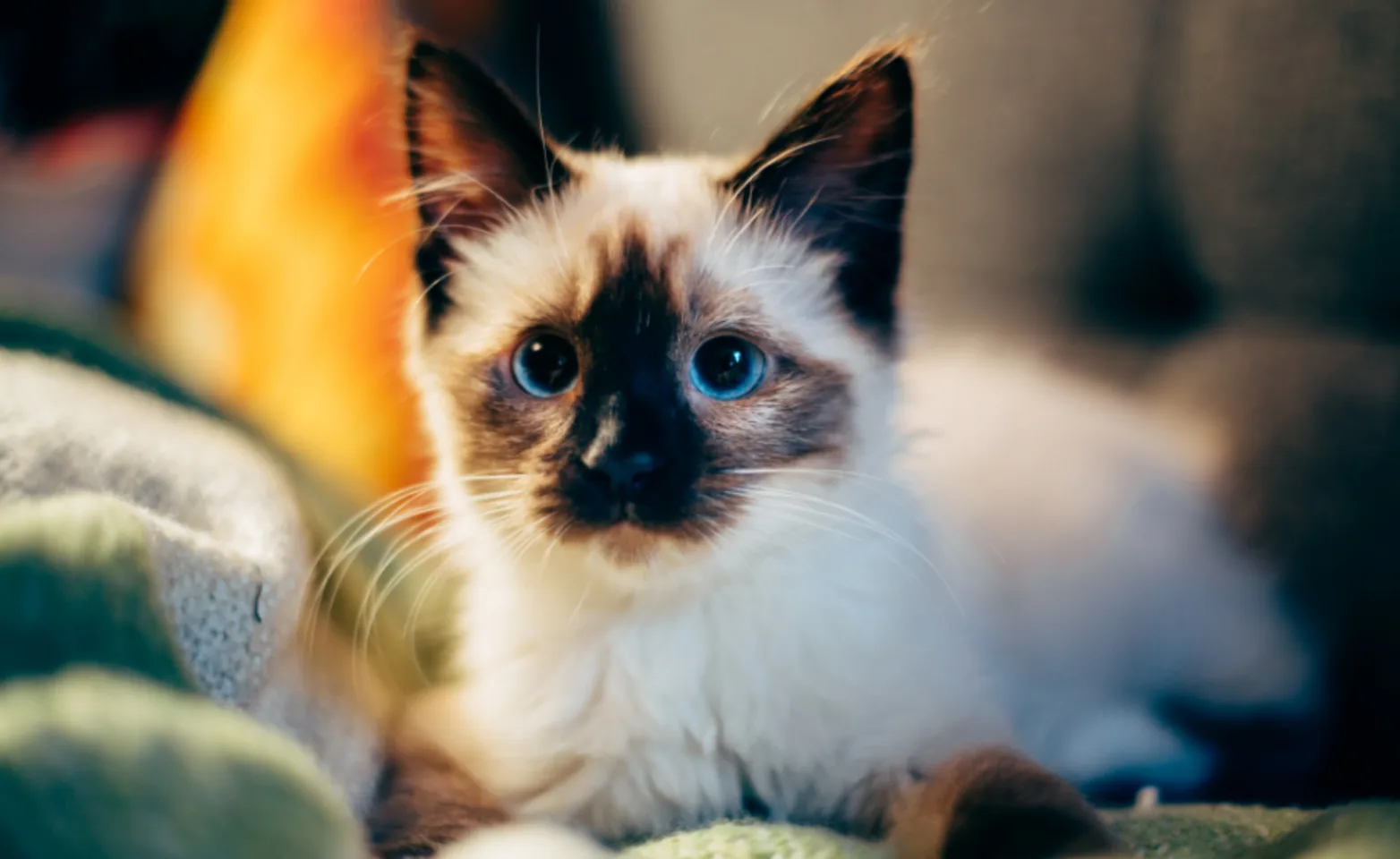
Nutrition
Proper nutrition is vital to your kitten's health. The right formula will provide the following benefits:
Optimal nutrient delivery to help build bone, muscle, healthy organs and teeth
Ideal skin quality and a luxurious coat • An improved immune response to optimize protection from vaccinations and for overall general health
Excellent digestion, gastrointestinal and urinary tract health
Superior nutrition can increase a cat's life expectancy
Choosing a diet
Choosing a diet for your kitten can be very frustrating. You may receive a lot of different information from breeders, family, pet store employees, the internet, television, etc. Kittens have specific dietary requirements that differ from those of adult cats. Mostly, they have different requirements for calcium and phosphorus, and, as a rule, a higher calorie requirement than an adult cat of a similar size.
The standard recommendations are to feed "growth" diets until the kitten reaches approximately 80% of the anticipated adult size. This generally occurs at around 10-12 months of age. An overweight body condition is an important risk factor for developmental orthopedic disease that will lead to arthritis. If your kitten is becoming overweight on kitten food it is recommended to decrease the amount fed and ensure they have adequate exercise.
Importantly, you cannot determine suitability of a product by looking at the label or marketing. When in doubt, ask us. We have the knowledge and training to give you the best advice on diet selection, and if we don't know we have access to veterinary nutritionists to consult with. In short, we are the best source of diet information for you and your pet.
Veterinary care nutrition kitten formulas are based on the most recent research and innovations. They address the specific needs of age, lifestyle and sensitivities. Highly digestible ingredients are the key to the high quality nutritional formulas.
How much to feed?
It is important to feed your kitten the right amount of food at proper intervals, but that can be tricky, as feeding requirements vary greatly from one kitten to another. The feeding guides on the food can or bag are just a starting point. It's critical to your kitten's health that his physical condition is monitored regularly and the feeding amount be adjusted as needed. Free choice feeding is generally not recommended, as it can contribute to obesity. Meal feeding also allows you to notice a decrease in your kitten's appetite very quickly, so a possible medical issue can be addressed before it becomes a larger problem. The best approach is to feed your kitten's daily allotment of food in two to three equal measured meals a day.
Canned vs. Dry
Both canned and dry foods can be good for your kitten. We encourage you to offer some of both types of food, and to try different flavours of a good quality diet. This has shown to decrease the "pickiness" of our older cats
What about raw foods?
Most raw diets have a large number of nutrient deficiencies. This may put them at risk of abnormal bone development leading to brittle, easily broken bones. Raw food also carries a high risk of bacterial and parasitic contamination which can make your kitten, your children, or even you very sick!
What Exactly Are Animal By-Products?
A by-product is simply "anything produced in the course of making another thing." When processing soybeans, for example, the by-product vitamin E is produced; other examples of by-products in food are vegetable oils, beef bouillon and gelatin. By-products are common ingredients in both human and pet food. Ingredients listed on pet food labels as meat by-products include organ meats such as liver and kidney, which have excellent nutritive value. They include the muscle meat, organs, and bones not intended for human consumption. Materials such as hair, horns, teeth, hooves and feathers are NOT considered by-products. When comparing animal by-product meals with their "regular" meal counterparts, the differences can be nutritionally insignificant.
For example, in the case of rendered ingredients (cooked to remove fat), the digestibility, and nutrient content of both poultry and poultry by-product meals are nearly identical. It is important to ensure the byproducts are named (eg. chicken, pork) and not some mystery meat when buying a food. When a manufacturer refuses to identify the source of the material the food should be avoided at all costs.
Should corn and grains be avoided?
There are no reasons why the majority of cats and kittens cannot have corn and grains. They are nutritious, highly digestible source of carbohydrates and proteins as well as beneficial fiber for digestive tract health. A very small percentage of cats will be allergic to the "glutens", which are the protein components. This percentage is much smaller however than the percentage of cats who are allergic to chicken and pork proteins. You will notice that cat foods have lower amounts of grains as cats are carnivores who require a higher level of digestible protein. Unbalanced diets can lead to nutritional deficiencies, poor growth or conversely obesity, and result in poor health.
What about treats?
Healthy treats are an important part of training, socializing, and just plain loving them. Training using food rewards is the easiest and most positive way to train a kitten — yes they can be trained! Human food should ideally be avoided from the start. This will reduce begging, stealing, and the risk of obesity.
The following foods may be dangerous to your pet:
Alcoholic beverages
Apple seeds
Apricot pits
Avocados
Cherry pits
Candy (particularly chocolate—which is toxic to dogs, cats, and ferrets—and any candy containing the toxic sweetener Xylitol)
Coffee (grounds, beans, and chocolate-covered espresso beans)
Garlic
Grapes
Gum (can cause blockages and sugar free gums may contain the toxic sweetener Xylitol) Hops (used in home beer brewing)
Macadamia nuts
Moldy foods
Mushroom plants
Mustard seeds
Onions and onion powder
Peach pits
Potato leaves and stems (green parts)
Raisins
Rhubarb leaves
Salt
Tea (because it contains caffeine) Tomato leaves and stems (green parts)
Walnuts
Xylitol (artificial sweetener)
Yeast dough or raw bread
Raw meats and bones
Many plants, household substances, medications, and other products are also toxic.
For a comprehensive list see: www.petpoisonhelpline.com and https://www.aspca.org/pet-care/animal-poison-control

The Litter Box
Not using the litterbox is one of the biggest reasons that otherwise healthy cats are rehomed or euthanized. Cats are very particular about where they go to the bathroom:
There needs to be at least I litterbox in your house for each cat, plus I extra. This means if you have 2 cats, we recommend you have 3 litterboxes.
Litterboxes should be in quiet areas away from appliances or air ducts that could come on and scare them. They also need to be easily accessible. Litterboxes should be available on each level of a home or in separate locations if the home only has one level to prevent one cat blocking access to another cat
Litter Type: Research shows that most cats prefer fine-grained unscented litters. Scoopable litters usually have finer grains than typical clay litter. Avoid air fresheners near the litterbox — cats can be deterred from the box by these smells.
◦ Once you find a litter your cat likes, don't change brands/types or your cat may refuse to use the box. If you need to change the litter, place a second box beside the old box with the new litter in it. Your cat can decide if she wants to use it.
◦ Litter should be about 2 inches deep
Litterbox type
◦ Cats generally prefer large uncovered litterboxes. The litterbox should be at least be large enough for your cat to stand up and turn around in
◦ Remember, the box should be at least 1.5 times the length of your cat.
◦ Many commercial boxes aren't large enough, so it may be better to use under bed storage boxes or large Rubbermaid bins with doors cut out of them (protect the cut edges with something soft).
◦ Covered boxes — some cats prefer this because of added privacy
◦ Remember these will concentrate odours more than uncovered boxes
Boxes need to be scooped at least once a day and washed once a week with mild dish detergent
Feline Idiopathic Interstitial Cystitis
We cannot mention every disease that cats get; however this is a common disease that can be life threatening if medical attention is not received immediately.
Feline idiopathic interstitial cystitis (also called feline lower urinary tract disease) is a condition that is just starting to be understood by the Veterinary Community. It is the most commonly diagnosed urinary tract/bladder disease in cats under the age of 10 years. Cats with this condition experience chronic, recurrent episodes of pain, irritation and bleeding in the bladder. Some cats actually cry out when urinating, other start to urinate outside of the litter box due to their discomfort. Male cats can have so much inflammation that they are unable to urinate. This becomes life-threatening as they can't eliminate wastes that buildup and cause kidney failure. If your cat appears to be going in and out of the litterbox more than usual and not producing their normal amount of urine, he should be evaluated by a veterinarian right away.
Obtaining a diagnosis in these cats is a challenge as many other conditions can affect the bladder and can cause similar symptoms yet are treated entirely differently. Multiple urine samples may need to be analyzed to screen for crystals, blood, glucose and concentration. A urine sample is submitted for culture to identify any bacterial infections. Radiographs are taken of the bladder to identify any bacterial stones that may be present. Some cats may even require contrast radiographs, ultrasound, or a cystoscopy procedure to confirm the diagnosis of Interstitial Cystitis.
Cats diagnosed with idiopathic cystitis have abnormalities of the nervous innervations of the bladder. When these particular cats experience changes in their environment or stress, these sensitive nerves than secrete substances that cause inflammation and bleeding in the bladder. This is a very painful condition for the cat. The pain in turn further increases the cat's stress level and perpetuates the disease process.
This disease is very similar to the condition of Interstitial Cystitis experienced by some women. Our cats have this disease for life where the symptoms wax and wane; however, effective management can control symptoms for years at a time in many patients. Unfortunately, some patients do not respond as well and will experience recurrent, chronic and occasionally unrelenting symptoms of pain and bleeding.
Although there is no "cure", a variety of treatments offer promising help for these cats. Treatment is directed at increasing water consumption to more effectively flush the bladder, decreasing anxiety, managing pain and identifying stressors in the environment. For some of these indoor cats, boredom in their environment is a sufficient stressor. Each individual cat responds differently to treatment attempts.
This is a frustrating disease to treat effectively for the veterinarian, yourself and your cat. With early identification of symptoms, patience, and willingness to both confirm the diagnosis and trial a variety of different treatments on your behalf, we can hopefully, successfully manage this illness.
For indoor cats "environmental enrichment can often relieve anxieties that have built up by the inability of our indoor cat to practice their natural predatory behaviours. Simply playing with your cat for only 20 minutes a day can make a big difference.
The Indoor Cat Initiative has a great website to obtain information and ideas on enriching your cat's environment.
The Indoor Cat Initiative can be found at: http://indoorpet.osu.edu/cats/.
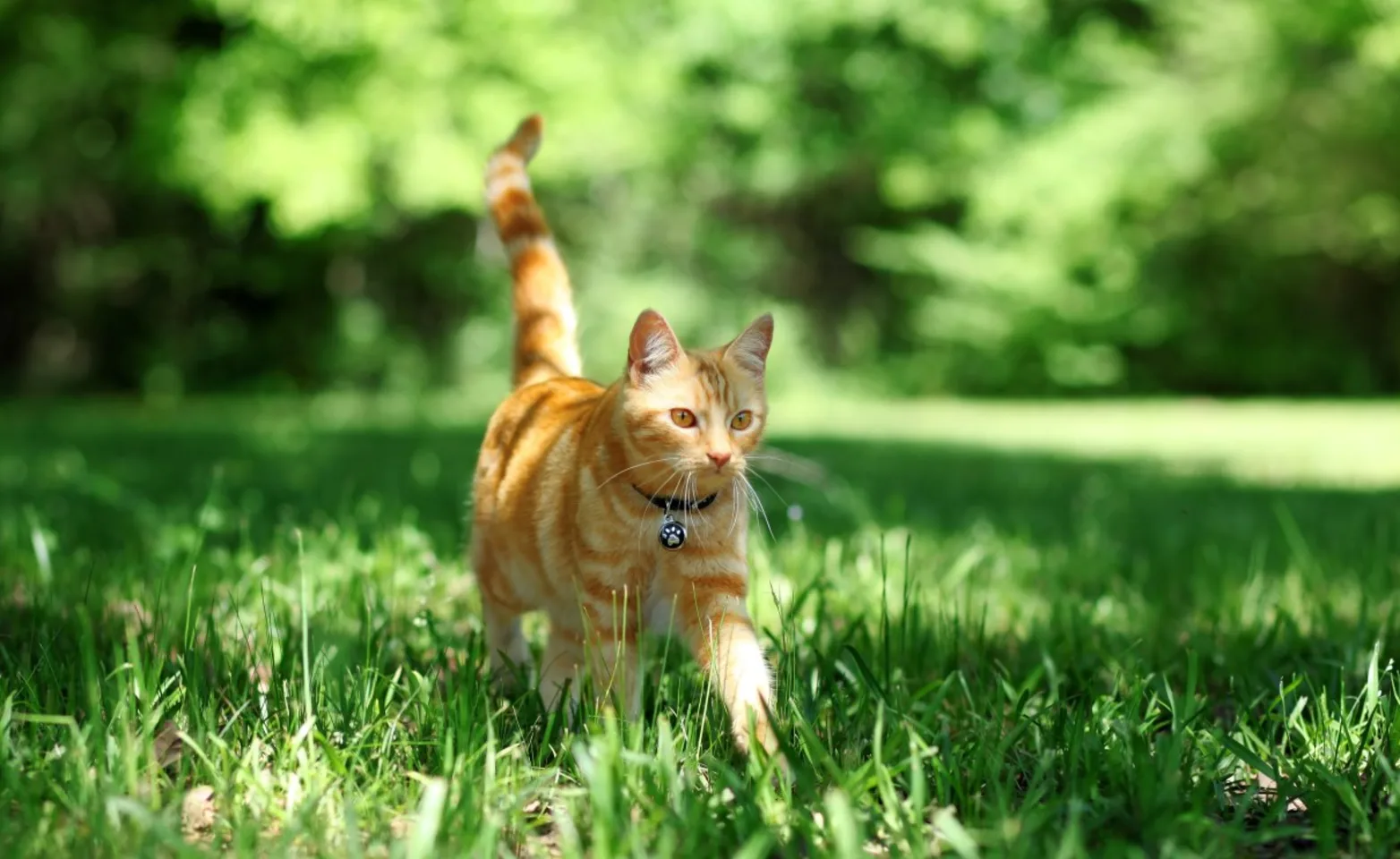
Outdoors vs Indoors
What is better for a cat? There are pros and cons to both lifestyles. Cats who roam outdoors are at risk of being hit by cars, fighting with other cats or being attacked by predators such as dogs or coyotes (or sadly people), and have increased exposure to diseases, parasites and toxins. Roaming cats also cause problems by digging and defecating in neighbours' gardens, marking territory by spraying and indiscriminately preying upon songbirds and other wildlife. Cats are curious by nature and have been known to become accidentally locked in certain areas where they have no access to food or water for days. Indoor cats generally do have a higher risk of obesity (which can lead to diabetes), so their feeding requirements and exercise regime need to be reassessed regularly. They also are still at risk for some infectious diseases that can be airborne or transported on our clothing, so they still need regular preventive care from a veterinarian.
Some cats aren't content living exclusively indoors, and this sometimes leads to problems with their urinary tract health. Sometimes we can change their minds with modification of their home environments (see the section on environmental enrichment). Many cats can be quite happy outside supervised with a leash and harness. Some cats even go for walks with their owners! Other options include outdoor "pen" areas that allow cats to interact with the outside world — grass, insects, birds and squirrels but keep them safe from predators or cars.
Environmental Enrichment
The cat's environment should be set to satisfy each cat's specific needs. Multilevel resting areas can be particularly important in multi-cat households. "Cat shelves" can be mounted on walls that allow cats to explore multiple levels in the home, and perches can be set up at windowsills, on bookcase shelves and appliances. The best "perches" are usually in sunny spots. Bird and squirrel feeders can be set up for the cat to watch, provided it does not increase arousal or frustration. Kitty condos also provide resting, play, and exploration areas. Cardboard boxes and paper bags can be placed around the home to encourage exploratory behavior.
Objects for the cat to scratch should be provided, including rope, carpet, and sisal-covered posts, fireplace logs, and commercial cardboard scratching pads. Some cats may like vertical areas to scratch, while others may prefer horizontal objects. You'll find out quickly what your kitten prefers.
Sensory Enrichment
These might include a radio, television, a DVD of animals, toys that squeak or are enhanced with catnip if the cat is responsive, as well as foraging devices. When choosing DVDs for cats, ensure that the subjects are prey or socially amicable cats to avoid potential redirected aggression. Some cats will be entertained by videos of wildlife or fish in an aquarium. For cats that enjoy chewing on fresh greens, gardens of sprouted wheatgrass or catnip can be provided.
Feeding
Toys are available that can be filled with canned food or "Kong stuff'n". Freezing the food in the toys will increase the time the pet spends with it. Other toys are designed to be moved around so that dry food or treats will fall from openings in the toys. Small stashes of food can be hidden around the home to provide a food scavenger hunt for the pet.
The family can have food-tossing sessions during which a piece of kibble or treat is tossed down the hall, up the stairs, or into a kennel for the cat to chase. A food dispenser that uses a timer to dispense food at intervals can be used to stimulate the cat throughout the day.
Manipulative Toys and Objects
Most young cats seem to enjoy stuffed toys that can be attacked — especially those with catnip. Feather or rubber toys on flexible wires that twist about are other good choices. Some cats find certain bird and dog toys appealing. Raw hide strips and other dog food chews can be used to keep cats busy. Rotating the availability of toys may increase their novelty and interest.
Make sure to make time every day to play with your kitten. You can use toys from the store or simply a ball of paper or foil that gets tossed around. Interactive play can be the best outlet for most cats' needs. Hands, fingers, and toes should never be used to encourage play.
Training
Using food lure reward training, most cats can be trained to sit and come on cue as well as a wide variety of tricks.
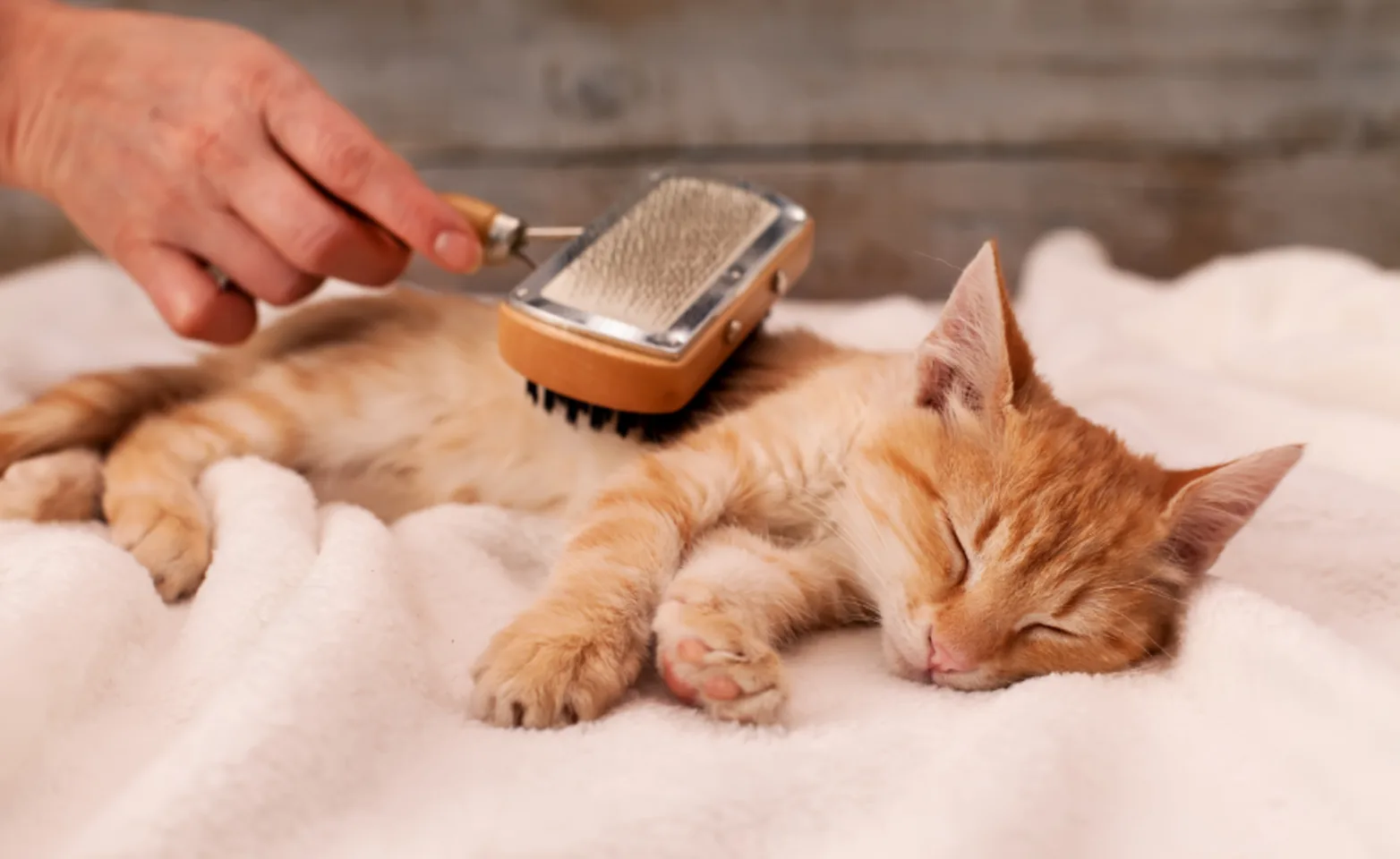
Grooming
Brushing
Long haired cats will need to be brushed regularly to reduce the buildup of painful knots or "matts" in their fur
Some long haired cats can benefit from regular "shavedowns" to remove or prevent matts
Every kitten/cat can benefit from a good grooming as it helps to remove any excess hair and dead skin cells, helping to minimize hairballs
Nail Trims
Nail trims can be easy if your kitten is used to having their paws touched. We can demonstrate how to trim their nails, but you can get them used to having their paws handled at home. This will make it easier for your kitten to accept having his/her nails trimmed.
When your kitten is relaxed, gently squeeze their paws to look at their nails. You will see a pink triangle coming from the toe with a pale white nail surrounding it. This pink area is called the quick and is the sensitive growing area of the nail, similar to our cuticle. After you have done this, make sure to reward your kitten!
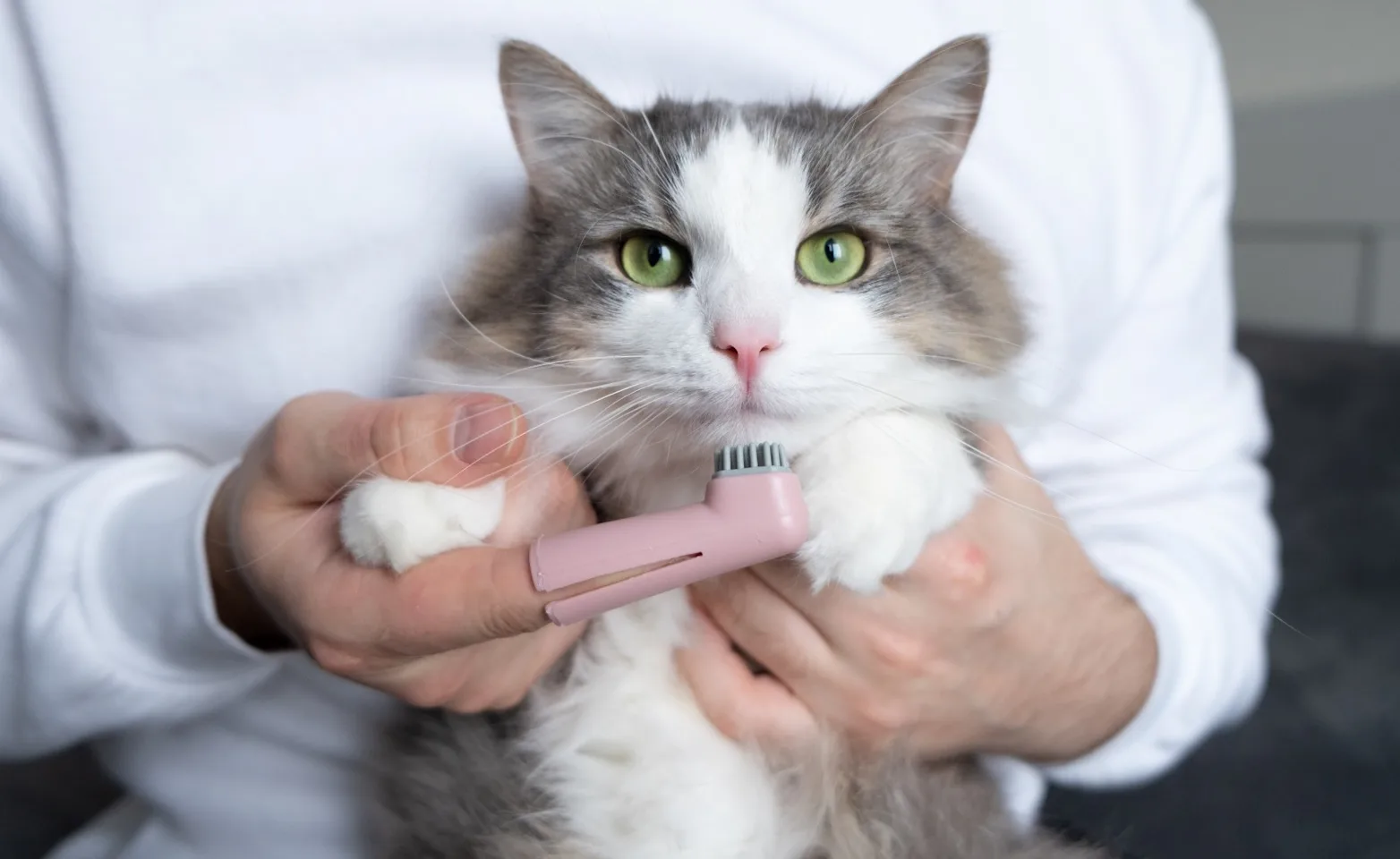
Dental Care
It is very likely that your cat will need dental treatment at some stage of their life. Regular dental home care can dramatically improve their oral health and reduce t the need for dental procedures.
Just like us, cats need to have their teeth brushed regularly to keep not only their mouths healthy, but the rest of their body as well. Many cats will allow brushing if a routine is introduced slowly and ideally early in life. You will need a small enough toothbrush to use in their small mouths, as well as toothpaste designed specifically for cats.
Performing dental home care can be easy when approached gradually. Ask us for more instruction on this or you can access a video below.
Prescription Dental Diets for adult cats have been specially formulated to help control plaque and tartar (brown stuff that sticks to the teeth, including under the gums)
Dental treats that carry the VOHC (veterinary oral health council) seal of approval including Greenies
Healthymouth or CET anti-plaque water additives and mouth sprays

Spaying and Neutering
This will be discussed by your veterinarian. Unless you are planning on breeding your kitten, it is highly recommended. Spaying is for females, and it involves removal of the uterus and ovaries. Neutering is for males, and it is removal of both testicles. The surgeries are very safe and pets recover quickly.
Why?
Behavior problems can also be prevented or minimized by spaying or neutering your cat. In 90% of male cats, neutering eliminated roaming, urine spraying, and fights with neighborhood cats, regardless of their age when neutered. Female cats no longer show "heat" behavior. Spaying a kitten early will also prevent mammary tumours as well as infections and cancers of the uterus or ovaries.
In seven years, an unspayed female and unneutered male cat can produce up to 781,250 kittens. Can all of them find good homes?
When your kitten is here for surgery a blood test can be done to check his kidney and liver function, blood sugar, proteins and red blood cells. Normal function in these areas is important to allow your pet to process and eliminate the anaesthetic medications they receive. Even in young healthy animals, abnormalities can be found that may indicate the need to select different anaesthetic medications or to delay the procedure until the blood abnormalities can be fully evaluated and hopefully corrected
Intravenous catheterization to deliver fluids should be done during the surgery.
The fluids help to maintain blood pressure and blood flow to vital organs. Anaesthetics decrease blood pressure and the intravenous (IV) fluids help to combat this side effect. The fluids are also warmed as they are going in, helping to maintain body temperature and allow a faster recovery.
Will my cat gain weight after surgery?
Obesity is one of the most common diseases in our patients. Your cat's metabolism does decrease by about 30% after he/she is neutered/spayed; however, you can prevent inappropriate weight gain by carefully monitoring their body condition after surgery and feeding appropriate amount of a diet as recommended by your veterinarian.
Microchipping
A microchip can be implanted in your pet at any time; however this is often performed while your pet is being spayed or neutered. A microchip ensures that your pet is permanently identified and can be traced back to you should your pet ever part from you. Should your lost pet be taken to a humane society, SPCA or veterinarian, your pet will be scanned with a special tool that will show your pets personal identification number. There have been many success stories of pets reuniting with their owners after years of being apart! You may think that it would be highly unlikely to lose a cat who is only indoors but cat's can sneak out even when you're being careful and become scared enough to run off. There have also been several incidents of pets being involved in car accidents and running away in fear as well as cats that escape during the chaos of a move between homes.
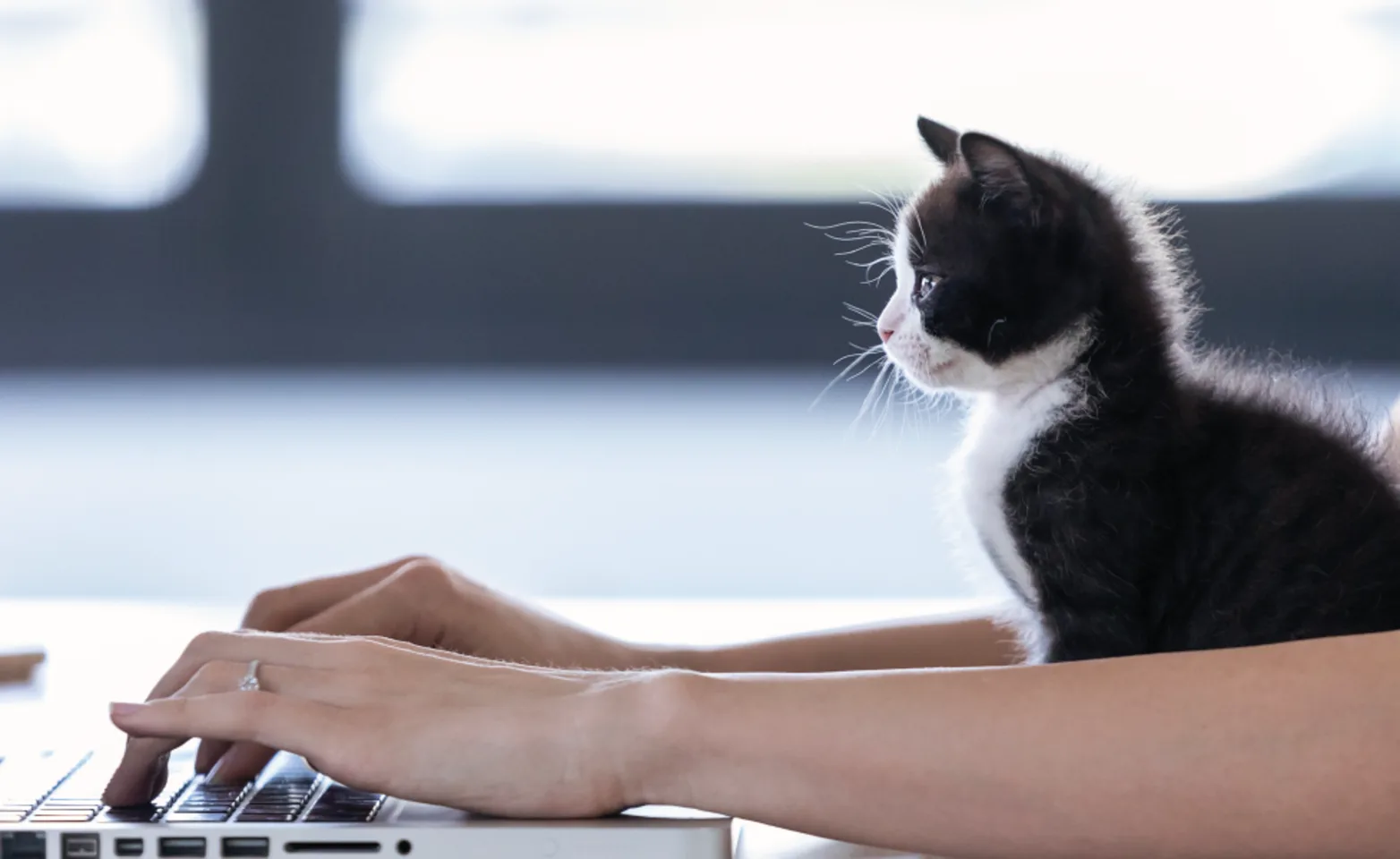
Pet Insurance
Adopting a new pet always comes with new challenges. Whether you have shared your home with many cats before or have never owned a cat, each cat is a unique individual with a new set of characteristics and (hopefully not too many) problems. There is always the potential for unexpected illnesses and injuries to arise that we want you to be prepared to manage.
We have provided you with the chance to sign up for a 30 day trial of pet insurance. This gives you the time to research different pet insurance companies and plans and to determine what is best for your needs, while your pet is still protected if anything unexpected happens during this period. This also allows you to begin a policy before any pre-existing conditions have appeared.
Pet Insurance helps cover the cost of medical expenses if your pet becomes sick or has an accident. This is becoming more and more useful as veterinarians are able to provide more intensive diagnostic testing and advanced care for our pets. Some pet insurance companies also offer Routine and Wellness coverage (vaccinations, annual wellness exams, spaying/neutering, medications etc) through different policy options.
Selecting a Plan
Selecting a plan is an individual choice because each person has different needs depending on their pet's breed, and their budget.
Look for a policy that covers accidents/injuries AND unforeseen illness
a. ie. cancer, heart disease, kidney disease, chronic liver disease, diabetes, hereditary/congenital disease and other disease/conditions specific to your pet's breed
b. and will continue to provide coverage for these diseases throughout your pet's life
2. Look for a policy that has no per-incident limits, allowing you to get the money you need in case of an emergency or extended illness
Questions to ask companies before insuring your pet:
What is not covered?
What are the per-incident limits?
What about ongoing conditions like diabetes?
What is the percentage amount paid to you by the insurance company? Make sure it is a percentage of the actual bill, not a percentage of a benefit schedule
What is the deductible — is it paid per category, per year, other?
Will premiums increase as the pet ages? How much?
Recommended Internet Sources for additional Feline Health information:
Martindale Animal Clinic: www.martindaleanimalclinic.com
American Association of Feline Practitioners: www.catvets.com
Indoor Pet Initiative: www.indoorpet.osu.edu/cats
Animal Behaviour Research Institute: https://www.animaledu.com/
American Veterinary Dental College:
Pet Health Questions: www.veterinarypartner.com
